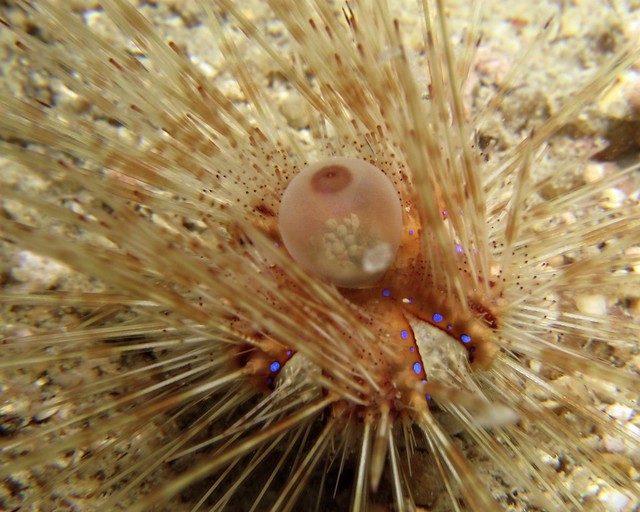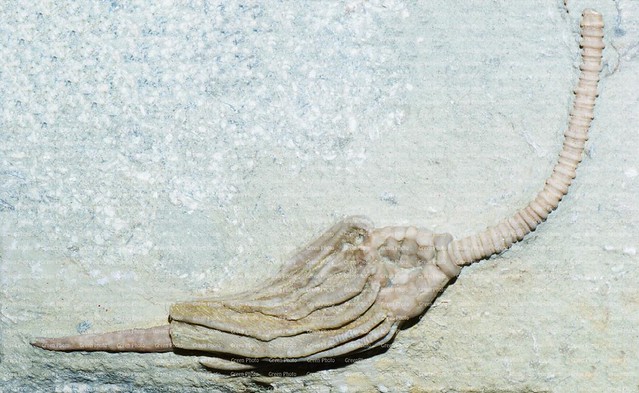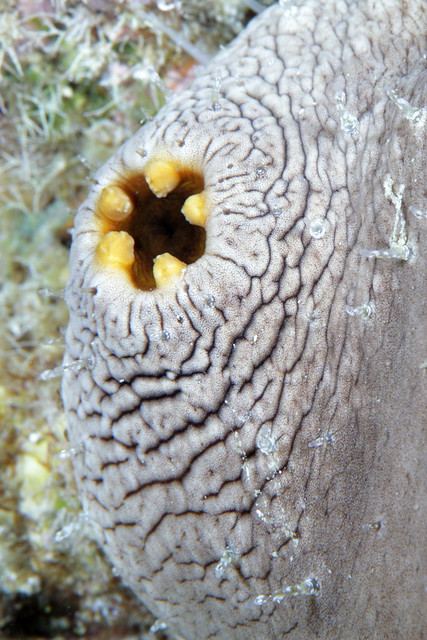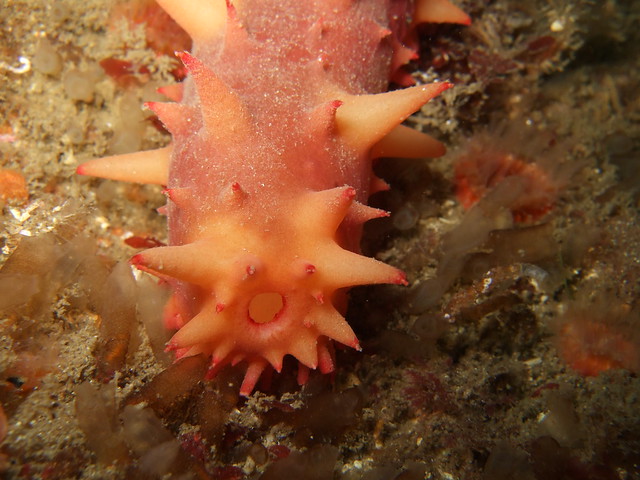This week, in the category of "one of those posts only Echinoblog could write"! Let us explore the vibrant diversity of echinoderm anal structures!! Perfectly SAFE for Work! even though it contains the word "anal" and "anuses" several times! WOO!!
Echinoderms are pentaradial (aka pentameral). That is they show a form of radial symmetry wherein their body always occurs around a top-down axis in five parts (although arms, etc. may vary).
As a consequence, the overall dynamic of their life mode is different from an animal with bilateral symmetry. No face, no "front" or "back". Thus, the way food moves through the body is different depending on where the mouth is located and consequently, where the anus is located!!
Since each living class of echinoderms has a fairly unique shape and body morphology, each group has a bunch of unusual specializations that function to facilitate the expulsion of poop!
To be honest, not every member of each class below has what is shown below. These are unusually prominent examples..but it still begs the question "What is it used for?" How many other animals have so many unusual anal adpations??
As a consequence, the overall dynamic of their life mode is different from an animal with bilateral symmetry. No face, no "front" or "back". Thus, the way food moves through the body is different depending on where the mouth is located and consequently, where the anus is located!!
Since each living class of echinoderms has a fairly unique shape and body morphology, each group has a bunch of unusual specializations that function to facilitate the expulsion of poop!
To be honest, not every member of each class below has what is shown below. These are unusually prominent examples..but it still begs the question "What is it used for?" How many other animals have so many unusual anal adpations??
5. Crinoids: Anal Chimneys & Pyramids
So, crinoids are suspension feeders. They almost kind of resemble plants. Most living ones are known as "feather stars" and are basically cups with arms for filtering water. But earlier forms of crinoids are known as "stalked crinoids" which have a stalk. I had a gallery of the older Paleozoic ones here a few weeks ago..
Here's a living one from the recent Okeanos Expedition to the Marianas region to give you an idea of what they look like..
So, the mouth in stalked crinoids is inside that cup at the base of where all those arms converge. The anus for these animals is ALSO in the cup. So, there's likely a strategy/adaptation for these animals to push the poop/excreta OUT of the anus, such at it does not end up getting "re-eaten" by the mouth...
According to Fossil Crinoids by Hess et al. there were several fossil (Paleozoic) forms which had fairly straightforward strategies for dealing with ensuring that poop was discharged FAR from the mouth..
For example, here is the Mississippian Uperocrinus nashvillae with an explanatory diagram from Fig. 37 of Hess et al's book. Basically that huge pointed structure on top? That's called the anal tube (or sometimes in other animals.. an anal pyramid or even an anal chimney!)
These extended structures serve to project the anus (and the excreted poop) well AWAY from the mouth (the feeding arms would come off right at that wide "ledge" around the center of the specimen..
There was a surprising diversity of these structures. Here's another one called Macrocrinus verneuilianus which is a fossil from the Carboniferous (the Paleozoic). The drawing below is taken from the Wooster Geologist blog and they point out that the elongate anal tube (in the lower left hand corner) aka the anal chimney may have even served an additional function beyond simply transporting poop away from the mouth:
The tube allowed waste products to be whisked away far from the mouth of the crinoid, which was at the base of the arms. Some researchers suggest that the long tube served another function as well: it may have helped stabilize and direct the filter-feeding fan of outstretched arms in a stiff current, something like the tail of an airplane or a panel on a weather vane.
One last weird crinoid is this one: Bicidiocrinus wetherbyi
Another Mississippian (i.e Paleozoic) stalked crinoid.. and this is kinda weird. So, there's the cup and the arms and that cone is the anal cone (=tube, pyramid, chimney, etc.) BUT it also has this weird additional protective "spiniferous canopy" around it!!
The diagram on the right shows this fully "reconstructed"..

Image of the fossil from http://louisvillefossils.blogspot.com/2014/08/bicidiocrinus-wetherbyi-crinoid-calyx.html
and the reconstruction from Hess et al. Fossil Crinoids-which is a GREAT book for these useful facts!
Ultimately, there is probably a WHOLE blog post or 5 about Paleozoic crinoids and what we know about their paleoecology.. I briefly touched on the snails that parasitize their anuses here.... One LAST MINUTE ADDITION: David Clark (@clarkeocrinus) provides this ASTONISHING Proteriocrinus with a very considerable anal chimney!! which looks to extend nearly the length of the cup and arms!
@echinoblog A Poteriocrinus from the Dev Arkona Fm in Ont of the John & Mike Topor collection. Quite a chimney! pic.twitter.com/gHG76PiLR5— David Clark (@Clarkeocrinus) April 26, 2016
Probably one of the best known but most poorly recognized of the various echinoderm anal structures is the ANAL SAC in diadematid (diadematoid?) sea urchins.
This includes Diadema, Astropyga, Echinothrix and all of urchins in this family. Usually these are tropical and characterized by long, sharp spines AND a very distinctive "anal sac" present on the TOP of the body.
The problem is that many people see this big eye-shaped ball on the top of the sea urchin body and assume that it is an eye of some kind...
I can tell you most DEFINITIVELY that this structure is NOT the eye. I actually explained in great detail here how this was actually the unusual ANAL SAC which is characteristic of this type of sea urchin for an error in New Scientist.
That said, they DID publish a WONDERFUL picture by David Fleetham of Astropyga radiata venting poop OUT of the anal sac!!
Basically, this is a transparent or translucent bulb or sac extension from the anus through which feces passes on its way out of the body.
See those little round things that look like corn kernals? Sea urchin poop!
Here's another great pic found on Flickr, taken by Eunice Khoo of what looks like a small Astropyga sp. clearly showing poop THROUGH the transparent walls of its anal sac (aka anal cone)..
Very nice capture.
But its not JUST shallow-water diadematid urchins that have this anal sac. Here's a deep-water Aspidodiadema from the recent Hawaiian Okeanos expedition. I talk a bit about these here
These were videos of these animals from 2000-3000 METERS below the surface. Aspidodiadematid urchins are classified in the same general group as diadematids. and they too seem to have this anal sac or cone...
2. Anal (or Epiproctal) Cone
Sea Stars/Starfish in a larger group called the Paxillosida (the mud and/or sand stars) have a specialized structure which sits right on the center of the disk called the anal or epiproctal cone.
A brief anatomical note- Although historically called an "anal cone" these starfish don't actually have a complete gut and so, the opening on the disk center is not actually the anus since it doesn't connect with the interestine. Hence the name "epiproctal": EPI is Greek for "upon" and PROCT is Greek for "anus".. hence the cone or structure UPON the anus..
The cone is basically an outpocketing of the body, extending UPWARDS through the sediment
 |
| From (Fig. 2 from Shick 1976) |
To quote myself from a few years ago:
Observations of Ctenodiscus under hypoxic conditions led to the illustration above. Basically, its thought that the cone gets more enlarged as hypoxia and hydrogen sulfide increases. The extension of the cone extends through the surface, with the tip at the surface. For your typical 6.0 cm diameter animal, these animals can have a cone that can attain 3 to 4 cm and extend 2 to 3 cm above the mud. It can leave this extended for over an hour. As the picture suggests, it can move around and push through sediment as the mud shifts, and etc. So, it can move around.
This also serves to make the top surface of the animal thinner, allowing easier gas exchange and opening up a channel to the surface water above the sediment surface!!
 |
| From Shick 1976 Marine Biology: http://link.springer.com/article/10.1007/BF00387613#page-1 |
So, in truth, the "anal cones" in these mud stars is NOT really an anus. Its where the anus would be located in other species..and so the labelling of this stucture is kind of a misnomer.. as they are not really used for defecation.
Other "mud stars" such as this deep-sea (3000-6000 m) Porcellanaster also have well-developed "anal cones". These starfish sit buried in sediment with these projections sitting up through the sediment.
In contrast this shallower water Astropecten armatus has a much less developed anal or epiproctal cone. This is also related to the fact that it occurs in shallower water and tends to bury itself in somewhat less sediment compared to the above two species.. |
| from CSU Fullerton: http://biology.fullerton.edu/biol317/ftm/ft_s15_cat_4_25_15.html |
And finally, one of the best known of echinoderm anal defenses: the anal teeth in sea cucumbers!
I've reported on these before. There's at least one interpretation that these structures are defensive in nature and work to keep pearlfishes (and likely other commensals or parasites) from inhabiting the cloaca.
There's quite a few crabs and shrimps that live in and around sea cucumber anuses. See more here.

Sea cucumbers get kind of a special award for using their cloacal and other "ass end" chambers most efficiently..especially since some species can actually FEED and BREATH as water passes through the anal opening!! Read more about that here.















6 comments:
What does the diadematid anal sac do with the poop once it has it? Is it serving a purpose like the crinoid anal chimneys (but seems less necessary here), or something different, like batching the release? (Like if predators would home in on continuous leakage, or I could make up other stories.)
So basically your question is, what is the function of the anal sac? I'm not sure its been positively identified. I suspect that for whatever reason, the sacs expel the feces farther away from the body. Perhaps because of their food? Other tropical urchins lack this sac so, hard to say.
Ultimately I'd love to know the function. Also wondered what had been observed about the behavior of the anal sac: like if the feces goes out detectably different than it went in, or if there are patterns to the timing of feces release, or other pieces that might put together the 'why'.
When I was a little kid, I thought the sea urchin anal sac was an eyeball... Anybody else?
Hi I was just wondering if those are gastropods of some sort clustered half way up the on the anal cone/chimney of the Uperocrinus nashvillae
Johnn
those are actually spines! But there are snails that do clamp down over the anuses of Paleozoic crinoids. Not here though. Great question. thanks!
chris
Post a Comment